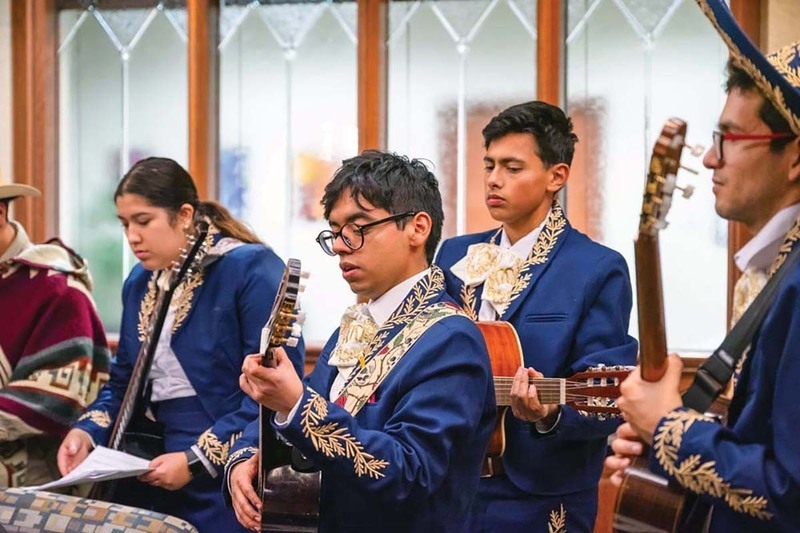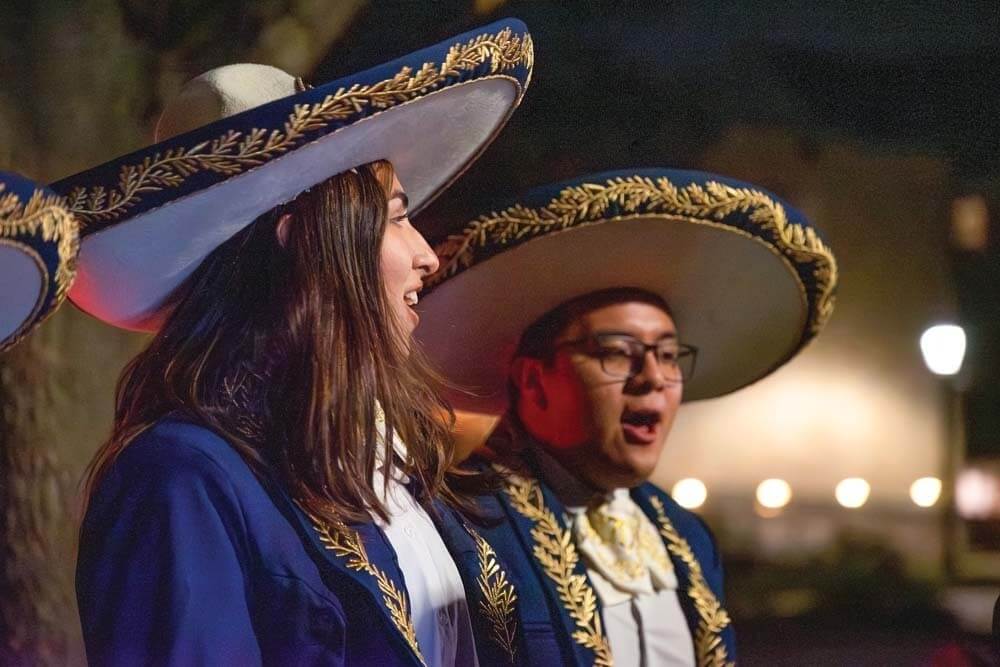 Photography by Mary Kate McGuirk ’24
Photography by Mary Kate McGuirk ’24
Goosebumps rippled up my arms as a breeze swept across the Library Lawn. The decorative silver botonaduras that adorned the sides of my long black skirt jingled as I stepped out onto the small stage for the 2021 Multicultural Showcase. My back snapped into place, my chin was parallel to the ground. I repositioned my violin, shaking off my sweaty hands, then raised my arm to cue the other mariachis. And we played. A ranchera valseada — a “ranch waltz” typical of this folk music form — echoed through the speakers.
The swinging of my bow to “Hermoso Cariño,” the warmth of the bright stage lights and the sweat on my forehead made me smile. For the first time since I graduated from high school and played at the 2021 Texas Association of Mariachi Educators finals, I was living the happiness of performing the songs that connect me to my roots.
Growing up in a Mexican household in the United States means listening to mariachi. Even in the womb I would have heard songs performed by the great Vicente Fernández and Juan Gabriel. Their sonorous tenor voices and the romping rhythms of the trumpets, violins and guitars always beckoned us to cry, dance and sing along.
Today, mariachi education is a growing phenomenon at all levels of schooling in many parts of the U.S. Still, as I left home for a predominantly white university in the Midwest, I thought I had closed an important chapter of my life. I did not expect to pursue my passion at Notre Dame.
Yet there we were before a new crowd, proudly wearing the black suits that the original members of Mariachi ND wore 27 years ago, performing music that emerged in the late 1700s in west-central Mexico and remains integral to Mexican culture today.
Mariachi ND is a student-driven group that has supplied the campus and South Bend communities with traditional mariachi music since 1995, when students from Texas founded the ensemble inspired by the performance of a few songs at the 1993 Latin Expressions campus variety show.
The original Notre Dame mariachis represented a cross-pollination of musical talent from the marching band, Coro Primavera, Sabor Latino and other groups. Together, the new ensemble created a 30-song repertoire to perform at LaFortune Student Center, Spanish Masses, paid appearances and impromptu serenades in the community.
Two of the founders, Veronica Pierce ’96 and Ian Hernandez ’97, say that initial band launched an alumni network of its own, with members coming together to share the milestones of their lives. “We realized that we had created the beginning of a legacy,” Pierce says, “and it’s something that we’re very proud of — that so many years later, we left this impact at Notre Dame.”

Mariachi ND, which became an official University club in 2015, gathers each Wednesday night to practice and prepare for paid gigs and performances on Mexican holidays: the Día de Los Muertos procession in November, the Feast of Our Lady of Guadalupe Mass and celebration in December, and Valentine’s Day serenades.
As a curricular counterpart to the student group, Paloma Garcia-Lopez, associate director of the Institute for Latino Studies, founded the Mariachi Education Program with the support of the ILS director, political science Professor Luis Fraga, and Professor Alex Chávez of anthropology. The program offers a new, one-credit class that I took in fall 2022, probably the first such course at Notre Dame.
Victor Pichardo, a musician, composer and educator, teaches the class, in which students learn the vocalization, instrumentation and ensemble techniques characteristic of mariachi, acquire the performance skills that create the ensemble sound and gain a broad knowledge of Mexican culture and mariachi music in its various forms — such as ranchera, polka and son.
Students at all levels of musical experience are encouraged to enroll, including those who have never taken a music class or are just learning to play an instrument. Mariachi ND and the ILS provide instruments and one-on-one lessons with Pichardo and other mariachi professionals.
After tuning and warmups, students often dive into a traditional song — occasionally stopping to fix problems with intonation or rhythm. Once students succeed with one song, they start to learn another. By the final class, students can play three popular songs: “Guadalajara,” “La Bruja” and “La Bamba.” “My goal,” Pichardo says, “is to continue giving the group more repertoire and for it to grow. I would like to see more students, more advanced and beginners.”
In fall 2022, we were all Spanish-speaking students, so Pichardo taught us in Spanish. But speaking the language is not a requirement, and he teaches in English when needed.
Pichardo believes the program will continue to grow. He considers its existence at a school like Notre Dame proof that “mariachi is the most important representation of Mexico in the world.” Given its increasing international presence, the music attracts many young people as they enter college.
“Rather than be shy of their culture,” says Father Joseph V. Corpora, CSC, ’76, ’83M.Div., the priest-in-residence at Dillon Hall, where the club practices, students “actually become more enthusiastic about it by learning more about it and celebrating it.”
“Being able to do mariachi is heartwarming,” says Christina Enciso, a junior who took Pichardo’s class and joined Mariachi ND. “There are not too many clubs or classes catered towards arts in diverse media, so being able to explore music that is so dear to my culture was amazing.”
For me and many others, mariachi is dearly important. Being able to play, practice and perform this music at Notre Dame is what I needed to call this University my home.
Lluvia Gaucin is a junior from Fort Worth, Texas, majoring in American studies with minors in Latino studies and in journalism, ethics and democracy.